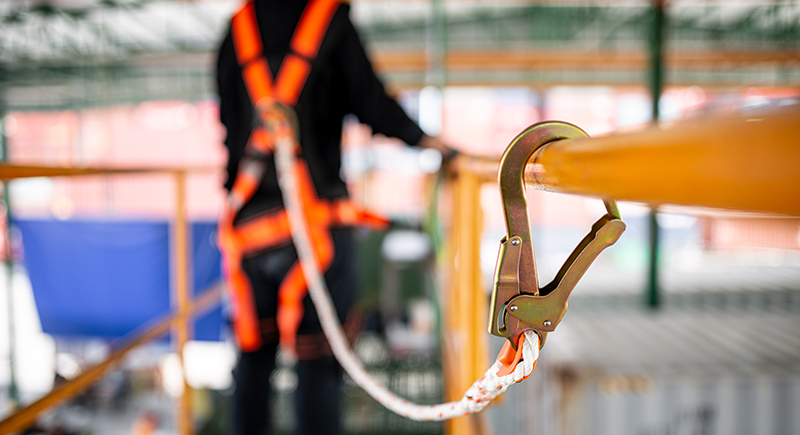Cover the Basics for Fall Protection Training
Train your employees on best practices

According to the National Safety Council, falls to a lower level are the third leading cause of workplace fatalities. In 2022, 700 workers died from these falls, and between 2021 and 2022 92,000 injuries resulting in days away from work were reported.
As with so many other accidents, the key to prevention is education. Be sure you’re covering all the bases with your workers for fall prevention.
Basic Fall-Protection Training
A little common sense can go a long way. Any fall prevention safety training class should start with the basics. Here is a checklist:
Fall protection checklist
- Your sense of balance is your first line of defense, even when using different kinds of fall protection. If you don’t feel steady, you should rethink the way you’re doing the job.
- Be aware of your surroundings including slip and trip hazards.
- Perform work at ground-level whenever possible to accomplish as many tasks as possible before climbing to a height.
- Speak up if you think work isn’t being done safely.
- Clean up after yourself and remind coworkers to do the same.
- Keep walkways clear.
- Stay within walkway limits.
- Use railings when available.
- Watch for cord covers, stair treads, and floor drains.
- Report any hazards you see.
- Wear slip-resistant footwear.
Everyday Training & Reminders
Once you’ve taught them the basics, be sure to reinforce lessons whenever you can.
- Send fun safety videos to your workers after trainings to keep them thinking about specific topics like guidelines for working near safety nets.
- Place safety posters in high-traffic areas of your workplace to promote smart safety practices when you’re not on site. Be sure to rotate posters on at least a monthly basis so people don't stop seeing them.
Remedies for Suspension Trauma
Suspension trauma is a lack of blood flow caused by remaining motionless in a vertical suspended position with leg straps pressing on arteries. This position and pressure mean the heart has to work harder to keep blood flowing to the brain and organs.
Teach the symptoms of suspension trauma including feeling faint or dizzy, heart palpitations, sweating, nausea, drop in heart rate/blood pressure, loss of vision, loss of consciousness. Stress that these symptoms can develop within just a few minutes and can cause a worker to go into shock or fall unconscious.
Demonstrate the remedies for suspension trauma including adopting a seated position using the leg and foot straps in the harness and ensure that everyone on the jobsite knows your worksite rescue plan to get a suspended worker safely down as soon as possible. Note that most suspension trauma straps are sold separately, so it’s important to add these as a required component in every system.
OSHA fall protection measures
In general, stress to your teams that fall protection is a safety measure you hope never to use and make workers aware of OSHA-mandated jobsite fall protection measures. Understanding these measures and the good they do will help keep workers from trying to circumvent them and will encourage them to speak up if they see them missing.
Guardrails
Workers should see guardrails when working on a platform, roof, loading dock, or other perched location that’s at or above the OSHA heights described at the beginning of this article. Ensure they understand that they should never stand on a guardrail and that guardrails are not an appropriate anchor point for fall protection systems.
Hole Covers
Holes and openings in walking surfaces are a common hazard when working on roofs or upper levels of buildings. Before beginning work, bring your working group around the site to point out holes and hole covers, both so they’re aware of the fall hazard and so they’re aware of potential tripping hazards from the covers themselves.
Safety Nets
If the job is especially high, safety nets may be required. Be sure workers know where these are located and ensure they realize that the nets are there to save their lives, but falling into one may still result in injuries.
Know the Numbers!
OSHA rules mandate fall protection when working at heights of:
- 4 feet in general industry
- 5 feet in shipyards
- 6 feet in construction
- 8 feet in longshoring operations
Fall protection and fall arrest equipment
- Fall Protection Systems – to prevent a fall.
- Fall Arrest Systems – to save you when you are falling from a height.
Teach workers to read the harness label to ensure that they’re selecting the right harness for the job. Harness labels should include information such as part number, model, and manufacturer, year of manufacture, harness material, harness size, fall arrest attachment elements, the purpose of any other attachments, use information, maximum user weight, and maximum free-fall distance allowed.
If any of this information is missing or not clear, the harness should be removed from service and deemed unusable.
Personal Fall Protection or Travel Restraint Systems
These systems prevent the wearer from moving beyond a certain point to prevent them from going over an edge or exposed area. A typical system consists of three parts: An Anchor, a Body Support, and a Connector, which are easy to remember using ABC.
Anchors: the secure point of attachment that’s strong enough to secure a worker even if they pull against the anchor point or if they somehow fall. Anchors must be able to hold at least 5,000 pound per attached employee.
Body Support: this is the harness that’s actually worn by the worker. Harnesses are designed to cradle a worker’s midsection and keep them connected to the anchor point.
Connecting Devices: these are lanyards, self-retracting devices, and lifelines that connect the anchors and body supports together. These components are often incorporated into other parts of the system and may not be entirely separate.
Personal Fall Arrest Systems
These systems are used when work must be done near an edge or when the working surface is too small to allow workers to remain away from an edge. They are designed to limit the free fall distance of the wearer to 6 feet or less and ensure a maximum arresting force of 1,800 pounds is not exceeded.
If the work environment includes surfaces with sharp, leading edges, lifelines and lanyards must include Leading Edge Capability, which means the line is durable enough to withstand these edges.
Safety managers should ensure that the proper calculations for fall clearance, lanyard length, deceleration distance, worker height, swing fall clearance, maximum fall arrest distance, and work area height have all been calculated and accounted for in assigning fall protection systems for any job.
Above all, when in doubt, ask for a recalculation or double check before working at a height!
Proper Harness Inspection
Along with supplying the right fall protection, it’s crucial to teach workers to inspect their body harness both before and after every use. Body harnesses should also be inspected by a qualified inspector every six months to a year, depending on use and working environment.
Before and after each use, workers should inspect their body harness for:
- Burns
- Cuts
- Tears
- Frays
- Abrasions
- Signs of rust
- Missing grommets
- Other factors that may compromise the strength and integrity of the harness.
If a harness does not pass the inspection for any reason, it should be marked as unusable or destroyed to prevent use.
Remember that these are just the basics, and your jobsite may include other hazards that need more extensive safety measures. While the lessons above are crucial for safety, remind workers that common sense along with their training and knowledge of safety interventions is their best defense. Staying aware of the environment, relying on their own sense of balance, looking out for each other, and speaking up about hazards and risks are tools they need to put on every day along with that safety harness!


